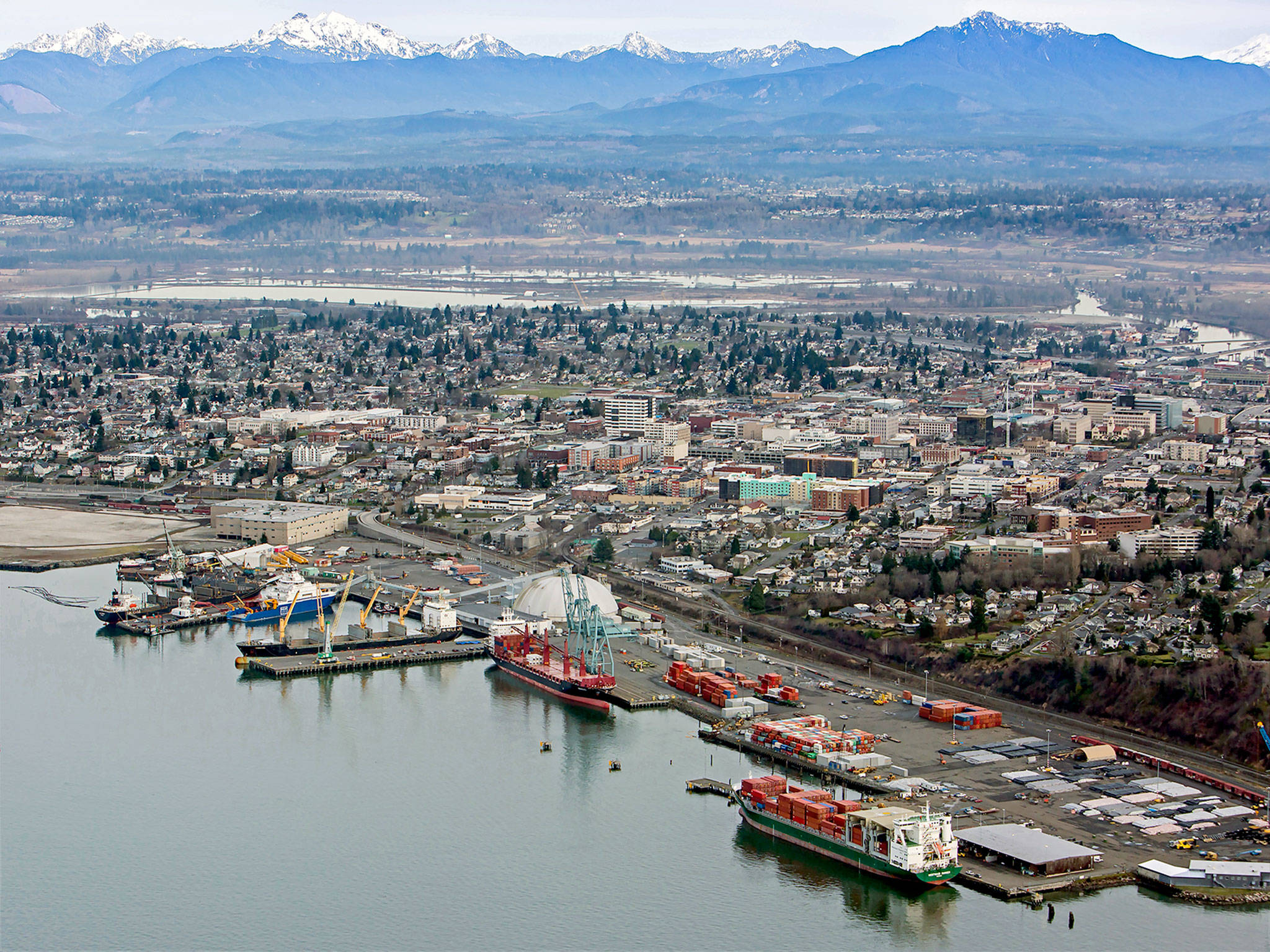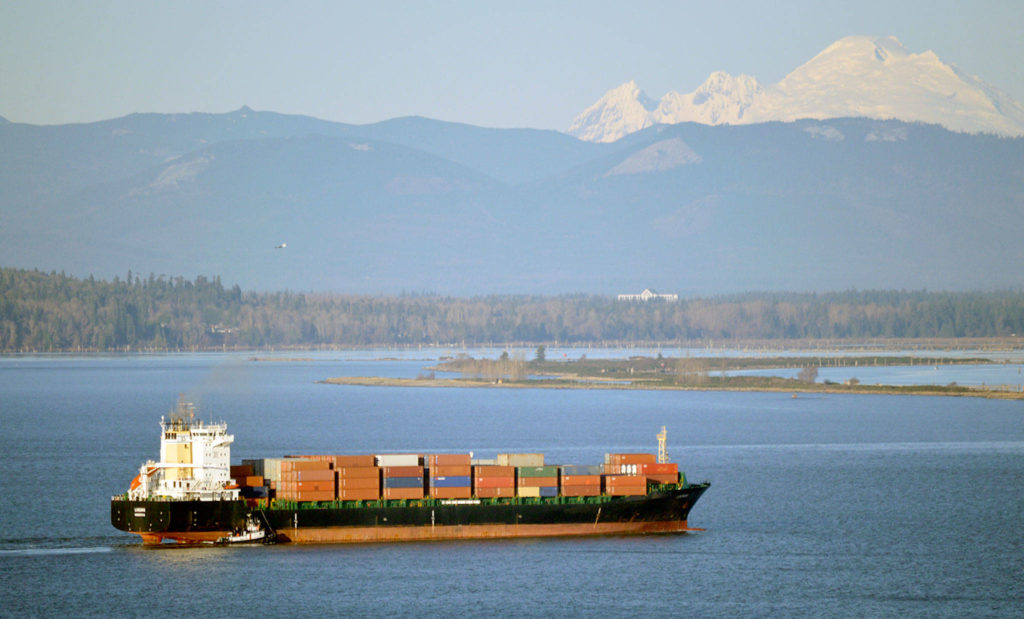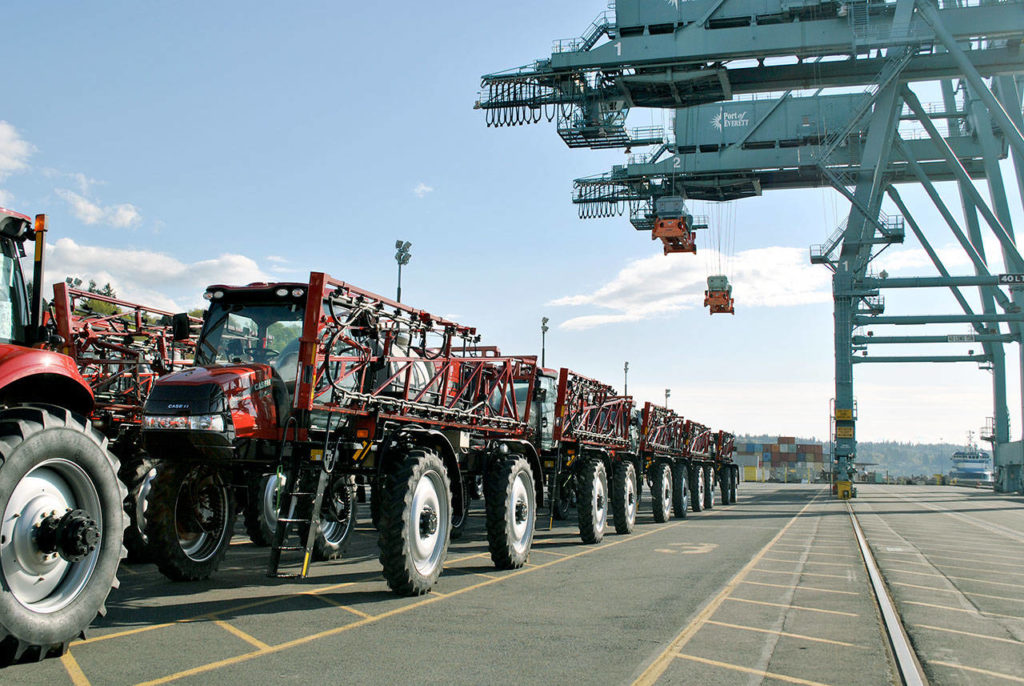This is one of a collection of stories marking the Port of Everett’s 100th anniversary in July.
EVERETT — The Port of Everett might not be a heavy-lifter. It ranks third in tonnage per year — behind the Port of Seattle and the Port of Tacoma.But when ranked by export value, it’s a major force in Puget Sound shipping.
The Port of Everett’s seaport processed $29 billion worth of exports in 2016. The Port of Seattle processed $22 billion worth that same year.
Those dollar figures are eye-opening for some local folks.
“It’s awfully quiet for being that busy,” said Everett resident Lee Schaefer. “It never seems busy and we’re just a few blocks from there.”
The Port of Everett is celebrating its 100th birthday this month. It’s modernly diverse, with a major marina and lots of waterfront real estate. But the heart of the enterprise still is the natural deep-water seaport just south of the giant white concrete dome that punctuates Everett’s waterfront.
As part of the working waterfront, the seaport serves ships from all over the world, including Japan, Russia, China and Australia, and it specializes in high-value, oversized cargo such as aerospace components, windmill turbines and blades and military equipment. That includes all the ocean-shipped parts for the Boeing 747, 767 and 777 production lines at Paine Field.
For the past decade, the seaport has contributed the whale’s share of revenue — 65 percent — derived from the Port of Everett’s three business segments: shipping, the marina and waterside real estate.
“It’s the port’s backbone — the financial engine that drives development of the recreational waterfront,” port spokeswoman Catherine Soper said of the seaport.
But tucked into a corner of Everett’s waterfront, it’s often overlooked — despite two towering, smoky-blue gantry cranes.
The seaport? “I never really see it,” said Dave Man, a Stanwood resident who grew up in Everett.
Man was enjoying the waterfront on a recent afternoon. He pointed to the marina and nearby Waterfront Center of restaurants and offices as being representative of the port.
He was impressed to learn the port’s value ranking, “That’s great!” Man said.
Need further proof of the port as major player?
Stop in for a chat with Ken Hudson, secretary-treasurer of the International Longshore and Warehouse Union District 32 in Everett. If he has a moment between phone calls, he’ll pull out a hectic schedule of ships, barges and union workers.
“We have a weekly call for Westwood ships. It’s 100 percent for Boeing,” Hudson said.
About a dozen workers are typically required to unload ships carrying aerospace parts, which dock about once a week at what the port calls the South Terminal. Mechanization has replaced the need for additional workers, Hudson said.
On a recent Wednesday, the Westwood Victoria docked at the South Terminal in the early morning. It took a few hours to unload the big green-and-white container ship.
“It’s leaving at 1 p.m.” Hudson told a caller. “If you want to see it, you better get down there.”
As a secure facility, the seaport isn’t accessible to the public. Depot Park at Bond Street affords an easily accessible view, though.
On that particular day, a little black-and-white tugboat maneuvered alongside the Westwood Victoria and attached a line. A puff of black smoke billowed into the air, signaling the tugboat’s engines were at full rev and ready to pull the Victoria from the dock.
At 1 p.m., a whoop went up from the deckhands assembled on the ship’s bow — they were on their way to the next port of call.
The big ships often arrive at night or in the early morning and are unloaded by midday — another reason folks don’t always see activity, Hudson said.
Other work takes place indoors, inside the seaport’s storage facilities, so residents might not see how busy the waterfront is, Hudson said.
Union workers were involved this spring in a three-month project to clean and detail military vehicles destined for Australia. Most of the work was indoors, he said. Another recent project involved prepping a fleet of Sikorsky Black Hawk helicopters for shipment. “Think how many millions they’re worth,” Hudson said.
To ensure the port can handle the next generation of container cargo, including aerospace components for the Boeing 777X, the port is investing $36 million from a combination of loans and state and federal grants to modernize the South Terminal, Soper said.
Built in the 1970s, the 700-foot concrete dock can support 500 pounds-per-square-foot, but that’s not enough for a new generation of aerospace containers, which are expected to be about 4 feet wider and 10 tons heavier.
To accommodate them, the terminal must be capable of supporting a minimum of 1,000 pounds-per-square-foot.
Work is under way to strengthen 560 feet of the 700-foot South Terminal. (A 140-foot section of the dock was strengthened in 2015.) The electrical system also is being upgraded so ships can tap shore power when they dock.
There’s more to be done, Soper said. The plan is to lengthen the South Terminal by 2020 so it can handle ships up to 1,000 feet. Now the seaport can accommodate only “disco-era ships,” Soper said, referring to the 700-foot ships typically built in the 1970s. The terminal’s additional length will accommodate newer ships built in the 1980s through the early 2000s.
Boeing, one of the port’s major clients, operates on a just-in-time delivery basis. Containers of aerospace components are offloaded and stored at the seaport until Boeing calls for them. When that occurs, they’re loaded onto a barge and ferried south to the port’s Mount Baker Terminal in Mukilteo.
The terminal, which began operating in 2008, can accommodate barges of about 300 feet, Soper said. Container ships can’t tie up there because “it’s not a deep-water port,” Soper explained.
Until the Mount Baker terminal opened, the giant aerospace containers, measuring 35 feet tall, 35 feet wide and 140 feet long, were transported from Everett’s seaport to Mukilteo by rail. The trip required closure of the Burlington Northern Santa Fe Railway’s main line between Everett and Mukilteo, disrupting passenger and freight trains for up to two hours, Soper said.
Now, when aerospace containers reach the Mount Baker Terminal by barge, they’re loaded onto rail cars on a spur line. From there, the cars cross the main rail line and take another spur, the so-called “Boeing line” built in 1968 by BNSF. Renowned for having the steepest grade in America — 5.6 percent — the rail line runs up Japanese Gulch to the Boeing plant at Paine Field, said Gus Melonas, a BNSF Railway spokesman.
With the Mount Baker Terminal, the shutdown time for the main rail line is typically less than 30 minutes, Melonas said.
“It’s a win-win for expedited service,” he said.
Janice Podsada: jpodsada@heraldnet.com
Talk to us
> Give us your news tips.
> Send us a letter to the editor.
> More Herald contact information.





























